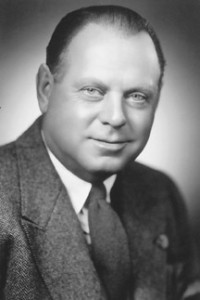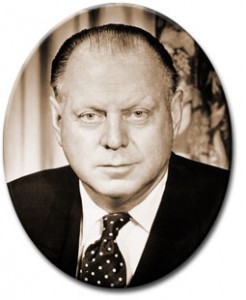September, 2015 – Bringing the Story of Harley Earl Back to the Spotlight
By Krista Martinelli
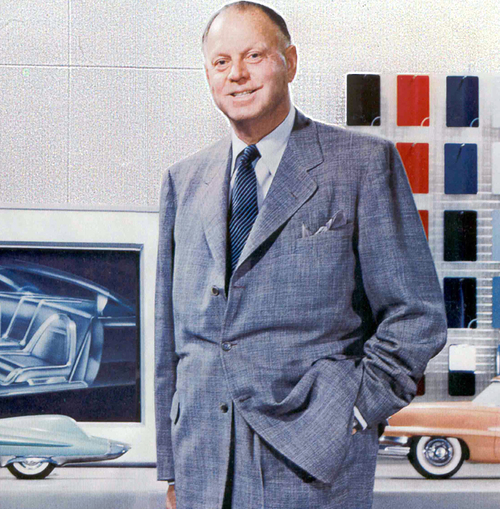
Harley J. Earl is “credited for single-handedly igniting an automobile renaissance. His legacy has been compared to Leonardo da Vinci and even Steve Jobs” (from “Steve Jobs and the King of Stylish Cars,” CNN, Thom Patterson). In America, we should know his name, as easily as knowing Ford and Edison and yes, Steve Jobs. After all, this new kind of “Car Architect” as Harley’s youngest grandson, Richard Earl, likes to say, also fathered the Corvette and launched so many other creative innovative new products and lifestyle creations The Detroit News dubbed him, The Man Who Invented The Modern Car after his 1969 death at 75 years old.
The Grosse Pointe News reported in 1997 that, “Earl (Richard) is planning to write a book about his legendary grandfather and moved from New York City to the Detroit area to pursue the project. Here he found that history is often controversy in this industry of high rollers, giant egos and big money.” 18 years later, Richard’s gained an incredible insight into everything past, present and future about the American auto industry.
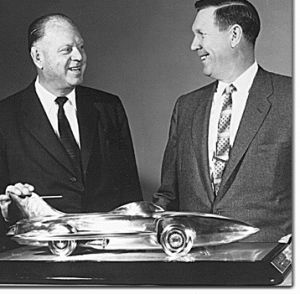
When I talk to car collectors, they do know of Harley’s legacy. Also, people who are interested in art and design are often familiar with his highly inspirational auto industry story. Earl was born in 1893 in Hollywood, California and died in 1969 in West Palm Beach. In between those dates, he did a lot for the auto industry and the modern business world in general.
Let’s look at his key contributions first.
- The Concept Car. Harley Earl began modeling GM’s dream cars of the future, something that had not been done before. His cars of the future were so forward-thinking; they “broke the mold.”
- His team of Women Car Designers. In 1955, Earl hired a team of seven women into his design skunk works. This naturally upset the all-male dominated engineering world at the time.
- Father of the Corvette. Earl was the designer and the inventor of the Corvette, which is now 60 years old. Most people don’t know it today but Earl was also a highly decorated auto engineer.
- The Annual Model Change. When Harley Earl entered the scene in Detroit, changing out the model of cars was not done every year. With his eye for design, Earl made it happen by anticipating America’s needs, coming out with a new model each year. He created a “business paradigm that’s shaped products throughout American industry, from can openers to tractors to iPhones.” (http://www.harleyjearl.com/topmilestones/)
- Clay Modeling and Graphic Engineering. Earl went about designing cars in a brand new way for his time. He was the first to make models out of clay, which continues to be done in 95% of the auto industry today. Bringing art and design to the table, he also used graphic engineering to design cars.
- Interior Design and Color. Before Harley Earl came along, we had Ford’s Model T’s which primarily came in one color – black. Earl insisted on colors (plural) and design as important aspects of the future of the car industry. Thus, a brand new DesignBuilding was born at GM. Detroit’s Dependency on Design, now the global automotive economy is hooked.
- Tailfins. What do you think of when you think of the era of classic cars? Yes, tailfins! Another key element that Harley Earl added to cars in the 50’s.
- Automobile Design. From the late 20’s to the 50’s, Harley Earl dreamed up cars that were ahead of their time. He married the auto industry with design. And gave birth to the whole industry of auto design.
- Making Detroit the Production Capital of the World. In the 30s, 40s and 50s in Detroit, millions of jobs were created. GM rose to being the number one manufacturer in the world, surpassing Ford by a long shot. Detroit was the design capital of the U.S., all thanks to Harley Earl’s vision.
I asked Richard about his personal relationship with Harley, but his being the youngest grandson out of eight grandchildren, he explains he didn’t get a tremendous amount of quality time but remembers one sweet ride in a custom Corvette around Palm Beach. It was a bright blue custom 1963 Sting Ray convertible with side pipes, and they raised eyebrows as they cruised around Palm Beach together, a thrilling day out for a young Richard. Realizing what his grandfather achieved, Richard now says, “My ultimate dream is to just become a small measure of success up against what other family members did for the American auto world, like my great-grandfather Jacob W.(JW) Earl and his son Harley.” Yes, Harley’s father JW was a late 19th century coach-builder who quickly transitioned into the automobile business.

Today Richard Earl gives talks about how inspirational leaders from Detroit’s mid-twentieth century, like Harley Earl, can broaden people’s vision and asks questions like, “How do we jump start America’s auto capital, so it can start having a repeat performance of its past glory?” when he talks to his audiences. When people talk about Detroit, it’s usually a story of “an epic fall from grace.” Where has our vision of the future gone? This is a question he has asked himself countless times. And the answer is easy, according to Richard. America’s auto industry leaders need to put design first again, ahead of everything else. “GM was so sophisticated in the mid-century,” he says. “It was the technology epicenter of the world and design was it’s sword of power.”
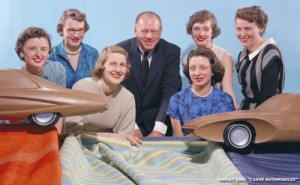
Another ahead-of-his-time trait of Harley Earl was being inclusive. He understood marketing. And even before the era of modern women’s rights, he said, “women influence 75% of all car purchases, and when women go shopping for automobiles they know what they want.” He hired a team of seven women to design the interiors of ten cars. His coworkers at GM at the time were shocked by this bold move. The media called this team of women the Designing Damsels. As Richard Earl re-tells the story, “Decades before there was any traction with women’s rights in Washington, DC, here’s this individual who in the largest business saying, ‘Let’s just hire women. And let’s elevate them.’ Harley Earl didn’t need a law passed in Washington. He just knew it was right.”
Harley Earl designed the Corvette. He had been a race car driver as a kid and spent time in Watkins Glen, New York with the racetrack community. He started seeing European two-seater cars and asked the question, “Where’s ours?” He wanted to know why the U.S. wasn’t keeping up. As Richard explains, he “fused art and engineering” to come with the Corvette. While Belgian-born Zora Arkus-Duntov went on to help make the Corvette competitive with a hard, performance edge, Harley Earl came up with the original blue print for the Corvette. Also, Earl believed in the Corvette and stayed loyal to it, even when it was initially disregarded by many. It’s similar to the story at Apple. Steve Jobs is the father of Apple and iPhones as we know them today, although Steve Wozniak is the engineer who made the vision come true in the early days of the company by building the first Apple computer. However, Jobs is the one that “thought it up” and pushed it forward. Just like Harley Earl and the Corvette.

Clay Modeling and Concept Cars
Earl had an experience as a teenager on a family vacation at Bailey’s Ranch in California, where he came across a clay hollow in 1908. He was fascinated with working with clay and made several clay models of future automobiles. He continued working with clay and even made large models, using saw horses for a foundation. Instead of not noticing what his son was up to, his father said to Harley, “You’ve really got something here.” The clay turned out to be a great blue print for designing automobiles. “In the 30s, 40s and 50s, Harley Earl brought design to Detroit, sparking a new flame that would create millions of jobs making Detroit the design capitol of the United States during the mid-twentieth century,” says Richard Earl.
Harley Earl was also responsible for the Concept Car. Again, the true Concept Car wouldn’t have been possibly without the clay modeling. His first Concept Car was the Buick Y-Job, and then he went on to make Concept Cars a way to test the response of the public, a way to bolster interest in the auto industry, and a way to bring car shows to the mainstream.
The Annual Model Change
The Annual Model Change was another big innovation which came from Harley Earl’s design center at GM. “This modern business invention, originally touted as the annual Styling Model Change by Harley Earl, remains to this day the lifeblood of capitalism and has morphed into almost every product design circle there is from Shanghai to Chicago,” says Richard Earl. Just think about the drama when Apple unveils its next iPhone every year. Or the next big product reveal from just about any company world-wide, whether it’s a new toaster, a new deodorant or a new computer. Annual model changes and new designs fuel capitalism. Before Earl, no one was asking for an annual new design in the car industry. With his Design Campus at GM, where he worked until retiring in 1958, Harley Earl made it so.
A Personal Sense of Style and Fashion
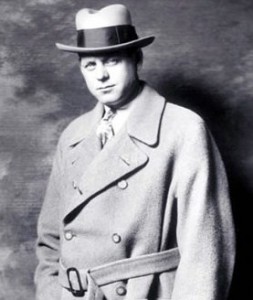
“Harley just had that sense – he always knew what he wanted . . . His cars were as flamboyant as his wardrobe,” says Richard Earl. See the video.
See what Richard refers to as the second greatest invention in the history of transportation (after the horse)! See the video.
A Bit of History
If you go to see Richard Earl speak, and I recommend that you do, you will find that there’s a big history component to the Harley J. Earl story. “GM was the arsenal of democracy during and after World War II,” he explains. He asks the question, “Why was GM investing so heavily in cars of the future, even before World War II was over?” This was at a trying time, when people were worried about the future and strapped for cash. It was this great confidence in America – that we would win the war. This spirit drove production.
For a short time, General Motors brought back the legend of Harley Earl in some TV commercials from 2001 to 2004. In this video with Tiger Woods, which Richard penned the original contract to get it rolling, Harley Earl is honored for his achievements at GM. See the video! https://www.youtube.com/watch?v=i4AOlgusDYw
However, we are all still waiting. Waiting for the leaders of America’s car industry to come around again and truly put design before dollar signs when they come out with their next cars. Waiting for the spirit of Harley J. Earl to come back into the industry. If that happens in his lifetime, Richard Earl will feel like he’s accomplished perhaps his most important mission.
Richard Earl’s Next Public Talk
Richard Earl to Speak about the Legacy of Harley Earl
October 10th, 6pm, Mandel Library, West Palm Beach, FL
This event is FREE and open to the public. See the flyer.
For more information about Harley J. Earl
Visit HarleyJEarl.com


